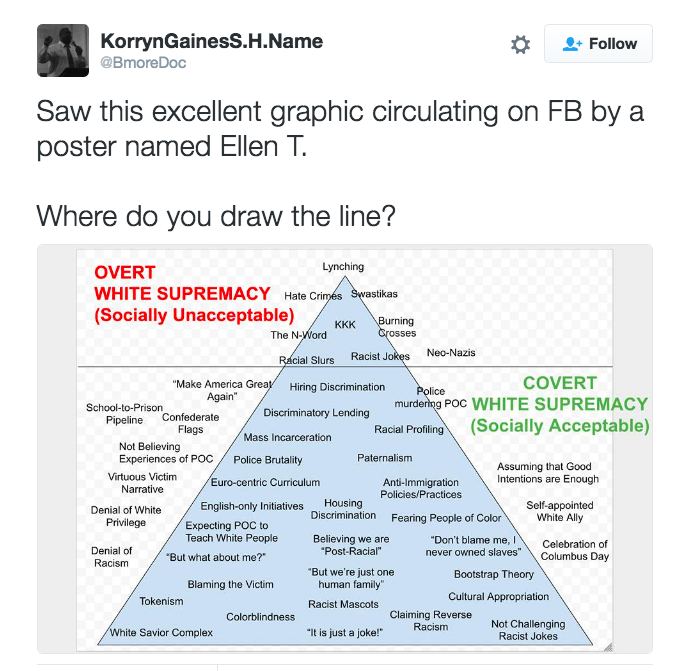Chart Reveals the Problem With the Definition of Racism

By:
The Black Lives Matter movement has again put the topic of racism into the national conversation. But modern racism is complex, and racism isn't as overt as the cross burnings or lynchings of the early 20th century.
Lawrence Brown, as assistant professor of community health and policy at Morgan State University, posted a tweet (from his @BmoreDoc Twitter account) that underscored the subtlety of modern racism and the fluid way that Americans express it while remaining "socially acceptable."
 Twitter/@BmoreDoc - twitter.com
Twitter/@BmoreDoc - twitter.com
The chart, which Brown found on Facebook, made a distinction between "socially unacceptable overt white supremacy" and "socially acceptable covert white supremacy." Society condemns historic examples of racism — lynching, Naziism, swastikas — but overlooks forms of institutional racism and more subtle stereotypes and prejudices that persist.
Here are some of the chart's examples of socially acceptable racism:
- Believing we are "post-racial."
- "English only" initiatives.
- Police brutality aimed at people of color.
Brown then asked the question: "Where do you draw the line?"
University of Southern California law professor Jody Armour told ATTN: that he considered the same question when he wrote about different forms of racism.
"This is something I've thought about for a long time when I wrote my book, 'Negrophobia and Reasonable Racism,'" Armour said. "I explored the distinction between stereotypes and prejudice."
To understand how modern racism works, we have to understand three ideas: prejudice, stereotypes, and institutional racism, Armour said.
Someone with explicit white supremacist beliefs — such as former Ku Klux Klan leader David Duke — is consciously prejudiced. Other people may not consciously think that one race is better than another, but they may act and speak in racist ways without realizing it, Armour said. Armour compared the behavior to driving.
"You can drive without thinking about it," Armour said. "Those well-learned sets of associations become mental habit. That's what a stereotype is: a mental habit."
Institutional racism can exist on its own, without individual prejudices and stereotypes, Armour added. American society is set up to promote racial and class inequality.
"You could have everybody wake up tomorrow without any racism or prejudice in their minds, everybody was just another human being like it was the Rapture, and nobody looked at color." Armour said. "Black people would still have a fraction of the wealth of white people. Black people would still be stuck in neighborhoods without adequate resources or impoverished schools. And they would still be stuck in those schools. The legacy of racism is something that can operate in the absence of psychological racism."
People may find it difficult to acknowledge the existence of institutional racism because it means admitting that they've had a built-in, systemic advantage in society.
"It's uncomfortable to admit that our privilege could rest on the oppression of other people," Armour said. "That could make our dinner taste a little funny."
How is modern racism different from historic racism?
P. J. Henry, a social psychology professor at New York University, wrote about the difference between modern and "old-fashioned" racism in a 2010 paper.
"Modern racism is a form of prejudice against African-Americans that developed in the United States after the civil rights movement of the 1950s and 1960s," Henry wrote. "It is characterized by beliefs that racism is not a continuing problem, that African-Americans should not put forth their own efforts to overcome their situation in society without special assistance, and that African-Americans are too demanding and have gotten more than they deserve."
New forms of socially acceptable racism – political suppression, mass incarceration, welfare reform — have replaced antiquated racist institutions such as slavery and segregation laws, lynching, and "whites only" drinking fountains, according to Henry's paper.
"The civil rights movement made these old-fashioned beliefs largely socially unacceptable, and although old-fashioned racism still exists in the United States, it has largely been replaced by modern racism," Henry wrote.
New forms of modern discrimination also apply to Latinos and other marginalized groups such as "women, recent immigrant groups, the obese, and gays, among others," Henry added.
"English only" initiatives are often politically motivated racist campaigns to keep the increasing Latino population at a disadvantage from the rest of society.
In an article for the American Psychological Association, a panel of "English only" legislation experts called "English only" initiatives "socially divisive" and a "threat to the human welfare."
"Today the initiatives dedicated to establishing English as the official language are orchestrated at the national level by a powerful and heavily funded political organization," researchers wrote. "Furthermore, this 'English only' movement has close connections to restrictionist, anti-immigration organizations, which suggests that the 'English only' movement has a wider, more far-reaching, and more negative agenda than simply advocating an official English language policy."
Writer Ta-nehisi Coates in an essay for The New York Times rejected the idea of modern racism as an individual's bigotry and instead described it as a broader systemic problem in American society. He described an incident at his former favorite New York City deli, where Black actor Forrest Whitaker was racially profiled and accused of stealing.
"The idea that racism lives in the heart of particularly evil individuals, as opposed to the heart of a democratic society, is reinforcing to anyone who might, from time to time, find their tongue sprinting ahead of their discretion. We can forgive Whitaker's assailant. Much harder to forgive is all that makes Whitaker stand out in the first place. New York is a city, like most in America, that bears the scars of redlining, blockbusting and urban renewal. The ghost of those policies haunts us in a wealth gap between Blacks and whites that has actually gotten worse over the past 20 years."
